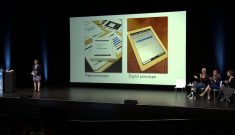
Dana Chisnell, co-founder of the Center for Civic Design, is a pioneer in civic design, and brings deep experience to that space. After working with banks, insurance companies, and tech companies for decades to help them improve experiences for their customers and workers, Dana takes that knowledge to the government space.
She started with research at the National Institute of Standards and Technology (NIST) into the use of language in instructions on ballots (with Ginny Redish), and work on standards and testing for poll worker documentation for the Voluntary Voting System Guidelines (VVSG). She has applied this work in dozens of states, and even advised election commissions in other countries.
Dana is an expert in plain language and usability for older adults, including groundbreaking work at AARP that was the basis for several requirements in the Web Content Accessibility Guidelines (WCAG). She became a Fellow in the Society for Technical Communication in 2007.
She teaches design in government at the Harvard Kennedy School of Government in the masters level Democracy, Politics and Institutions program. She also teaches with Whitney Quesenbery a course on design in elections that is part of the Election Academy at the University of Minnesota – the first university program to professionalize election administration.
From October 2014 to October 2016, Dana did a tour of duty as a “generalist problem solver” for the United States Digital Service in the Obama White House, doing user research and civic design across agencies. Her particular focus was on helping US Citizenship and Immigration Services modernize its software development and design practices to improve experiences for immigration officers and the public. She also helped the Department of Homeland Security design a more modern, agile, and design-forward procurement process.
As the editor of the Field Guides To Ensuring Voter Intent, she has taught thousands of election officials how to improve ballots, voter guides, web sites, and other election materials to ensure voter intent. She worked on the Anywhere Ballot, a ballot marking interface tested for accessibility by people with cognitive disabilities and low literacy.
Dana and Jeff Rubin wrote the Handbook of Usability Testing Second Edition (Wiley 2008), the seminal book on the topic.



